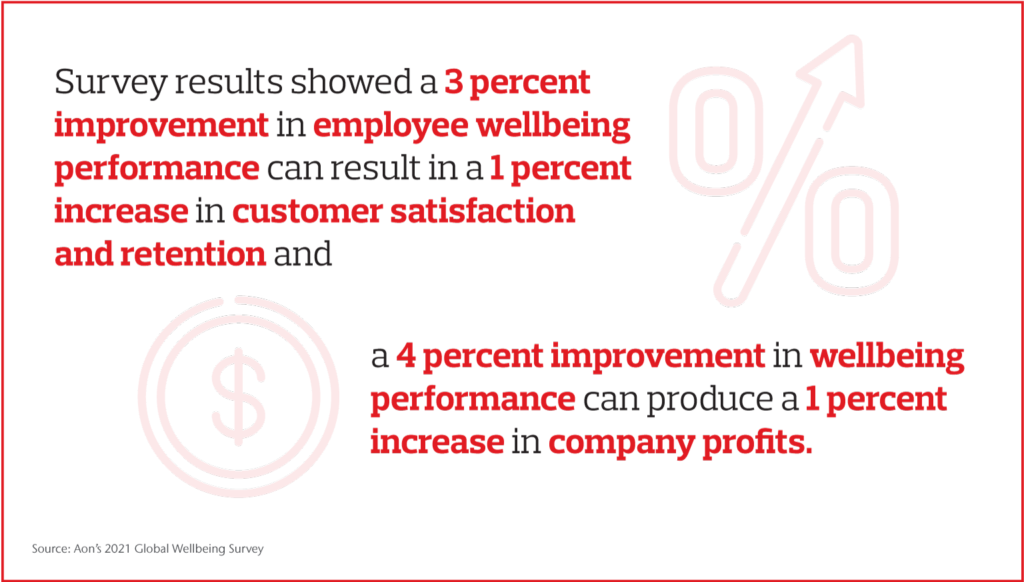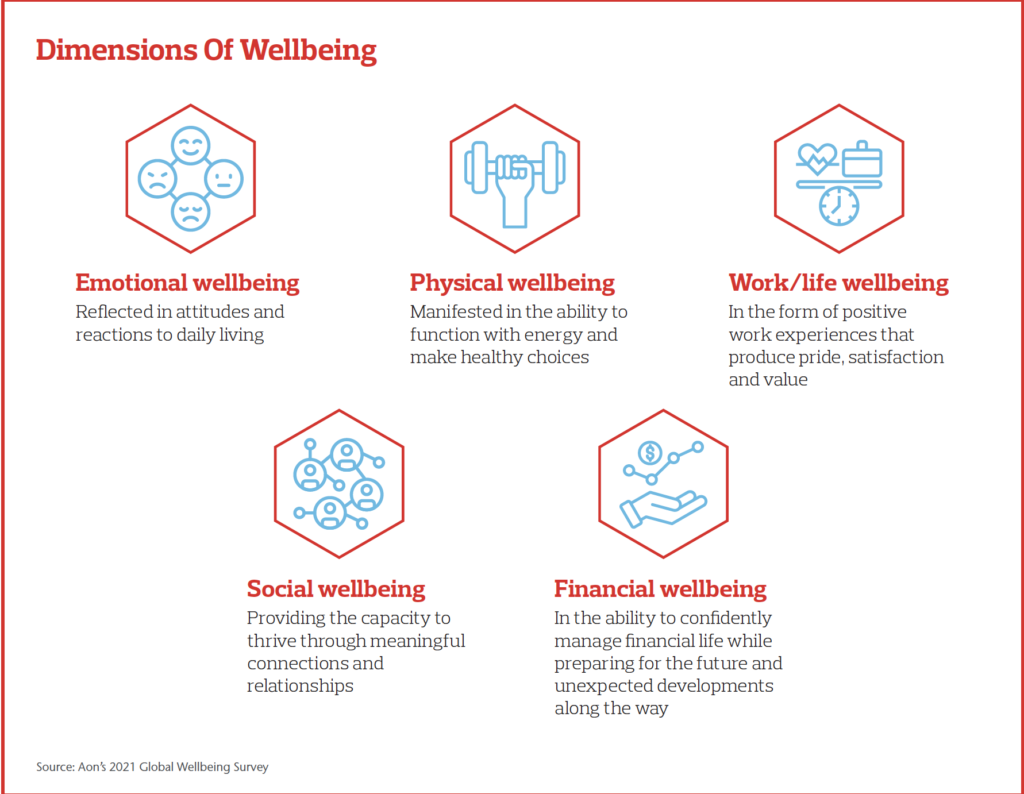June 23, 2021
Overview
The COVID-19 pandemic has caused levels of employee stress, burnout and anxiety to rise exponentially over the past year, highlighting the importance of worker wellbeing programs as an essential element of business strategy. Now a new Aon survey finds that employee wellbeing not only has a direct relationship to company performance but to customer satisfaction as well.
Covering 1,648 businesses in 41 countries, Aon’s 2021 Global Wellbeing Survey found that a strategy focused on improving individual and organizational wellbeing had a real impact on improving business outcomes.
For businesses, wellbeing should be a people and performance approach that balances resources and opportunities with a commitment to achieving optimal health, resilience and performance for the employee, the business and the community.
“It isn’t about taking a lot of initiatives and throwing them at the wall to see what sticks,” says Stephanie Pronk, senior vice president and leader of the health transformation team at Aon. “It’s being strategic, involving leadership and changing mindsets about wellbeing that leads to good wellbeing performance that then increases business performance.”
In Depth
“Wellbeing performance” can be measured by pulling together the different metrics that companies use to understand the success of their programs — such as employee satisfaction, stock value, retention rates and absenteeism.
Aon’s recent wellbeing survey showed that a 3 percent improvement in employee wellbeing performance can result in a 1 percent increase in customer satisfaction and retention, while a 4 percent wellbeing improvement can produce a 1 percent increase in company profits.

Why this tie between greater wellbeing and better customer satisfaction? “Anecdotally, we’ve seen that employees with higher levels of wellbeing can bring more energy and focus to their roles. In client-facing roles, that means they tend to be more present, responsive and better equipped to bring fresh ideas, navigate challenges and contribute to a positive customer experience,” Pronk says.
“While a 1 percent improvement may be modest in terms of business outcomes, the power is that it begins to show the connection between wellbeing and performance,” says Pronk. “And it means that now we can start to look at developing metrics within organizations to be able to show that connection.”
The Wellbeing Ingredients for Building a Resilient Workforce
There are several essential elements that must be part of wellbeing efforts in order to build a resilient workforce.
Strategy — Creating a healthy, high-performing workforce means going beyond piecemeal wellbeing apps and programs. It requires a strategy.
Around the world, 82 percent of organizations believe wellbeing is important within their company and have made it an area of focus, according to Aon’s 2021 Global Wellbeing Survey. While many organizations recognize the importance of wellbeing, fewer actually have a clear-cut wellbeing strategy. The survey also found that of the 87 percent of companies globally with wellbeing initiatives only 55 percent have a wellbeing strategy.
“When tailored programs and interventions are designed with the employee needs in mind and to address what is truly relevant based on data and insights, the strategy comes to life, and it is noticed and supported,” says Violetta Ostafin, CEO of Health Solutions, Aon Latin America. “That is when we see better results and real change happen.”
A robust wellbeing strategy stems from a clear vision and is tied to measurable objectives, Ostafin says. Leadership commitment is critical to align these within the company context and culture and ensure the right resources are put behind them. This is how to connect performance and wellbeing, by reaching beyond loose efforts or individual activities.
Leader champions A connected view of wellbeing should be the result of bringing together the interests of the chief executive officer, the chief human resources officer and the chief financial officer.
“By bringing the CEO and the CHRO together, the wellbeing story becomes part of the DNA of the business. It becomes part of the way the organization does business, both from a customer and an employee perspective,” Pronk says.
Meanwhile, more and more CFOs are looking at wellbeing from an overall business perspective, she says. “CFOs are recognizing the ability here to increase profits, improve employee retention and reduce turnover,” Pronk says.
Beyond the C-suite, however, the commitment to wellbeing has to exist at an operational level with the frontline managers. Working together, the CEO and the CHRO can ensure that the commitment remains strong at all levels of the organization.
Mindset shift Historically, “wellness” sat in HR and was seen only as a tool to change employee behavior. Treating employee wellbeing as a strategy that can influence company performance requires a shift in mindset, according to Pronk.
The Aon survey showed that company culture was the top driver in developing a business case for wellbeing. To that end, it’s critical to recognize that a wellbeing culture is not an initiative or collection of initiatives, but a change in how work is conducted.
Culture must come first, as company cultures determine whether wellbeing programs flourish and produce desired results or wither away, Ostafin says.
How do you know if you’re producing desired results? With thoughtful measurement.
Measurement Metrics can help determine whether an organization is getting its desired outcomes. Businesses that view wellbeing as a people and performance strategy and part of the way they do business and shape the work environment can look to business outcomes for evidence of the wellbeing strategy’s impact.
“For example, we worked with one organization that wanted a single, comprehensive wellbeing metric to include as part of their overall business scorecard. Over four years, there have been years where the score flipped better than others, but it gives leaders an indication of where things are and what needs to be tweaked to help them move forward,” says Pronk.
“The power comes when your wellbeing approach is strategic and interconnected and you can show larger business results, whether that’s around people or customer satisfaction and retention,” says Pronk.

Wellbeing Success Starts With a Strategy
A business couldn’t expect to succeed without a strategic direction and leadership support. The same goes for wellbeing: organizations should view it as a people and performance strategy instead of collection of initiatives or apps.
“We still have a very big gap between employers that are doing wellbeing initiatives and those that have a strategy and leadership buy-in,” says Pronk. “But what’s exciting is the momentum. I’ve never seen employers and communities and countries embrace the importance of their populations’ wellbeing as we see now.”
The post Why Workforce Wellbeing is Vital to Company Performance appeared first on The One Brief.
